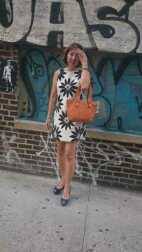
Question 28: What is your daily schedule like as an artist?
I didnʻt know what this should look like when I chose to pursue my art full time. The photo above shows me in New York on my way from Sweden to Hawaii when I decided to quit my full time job in Sweden working for the Volvo Group at their headquarters. I had a great vacation here and even had a group show at one of the galleries.
My week is split over preparation, production and business maintenance.
What I mean by preparation is I need to spend time researching, thinking, doodling my way to the next painting or collection. I need to practice my skills, like a musician or singer or athlete. Preparation is often seen in sketchbooks of artists, but it isnʻt only found there. Just browse the Brooklyn Libraryʻs Sketchbook collection. So I call this preparation. Then production is well, okole on stool and brush or pencil in hand and doing it, the art making. Business maintenance is my weakest point, but I work on finding funding, support, publicity, recommendations and commendations to build my brand and reputation. This also includes the writing, producing content, cataloging my work, storage, shipping, sales, paying bills, marketing, etc.
So my ideal day is 2hr prep, 4 hr production, 2 hr business and then I have the rest of the time for my family and health. I often can spend 6hrs in painting or even more, if I keep my health up then I have the stamina to do longer hours at the easel.
What is underestimated or underappreciated, especially with watercolor is the prep time. Alot of it art making is in the gestation and preparation of the idea and techniques, etc. so when you actually sit down to paint, it goes quickly and flows. Yes, flows–haha, like water.
So the question wasnʻt asked by these young artists, but I get it alot from curious collectors or admirers: How long does it take for you to do a painting?
Question 29: Were there other careers you had in mind?
I didnʻt have an idea when I was younger, while in school. My high school aptitude tests and counselor said I would make a good trial lawyer and teacher. In college they said I would make a good mental health counselor and teacher. But I didnʻt feel the ʻcallingʻ. I wanted to make books like Ezra Keats, The Snowy Day was my favorite book. I wanted to make important books, like illustrate the Bible or biographies, this was before graphic novels were a thing and there were more than Marvel and DC so I didnʻt know you could make a picture book for adults. So I looked for jobs that let me be creative in my thinking and problem solve. It led to many interesting jobs and I learned the tools I needed as I went along. Pagemaker, QuarkXpress, Photoshop, Freehand, Illustrator, CAD, HTML, SQL, the tools always changed but solving problems and helping people doesnʻt really change.
Had I known more about certain professions earlier I might have found industrial design interesting, or filmmaking. But I just got certified in video production a year ago, so you can always learn something new.
Question 30: When did you know you could make a living as an artist?
I think when I decided that being an artist didnʻt have to mean selling paintings in a gallery and using that income to pay all my bills. So by that definition, it started in 2014, when I decided to only work full time on my artistic projects and not for anybody else.
Some people finance their career by having a Theo to their Vincent van Gogh. In other words, they have a sponsor who believes in them and the importance of their work to support them.
Some people finance their career by working side jobs to pay for them to work on their work. These people work art related or not art related jobs as vocation to finance their avocation.
Some get state or private funding to do jobs permanent or project based to do their work. Those who get grants or other funding to pay them to do their work are the ones most often called artists in the media.